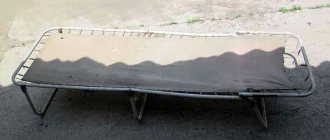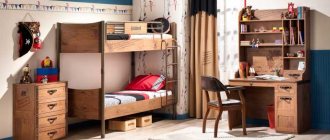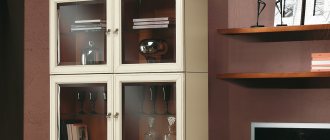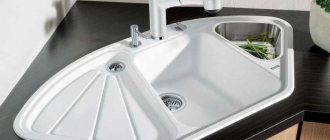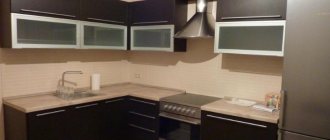Dish drying rack in the cupboard: selection and tips
To save space in the kitchen and hide dishes drying after washing from prying eyes, it is better to purchase a drying rack that will be located inside the kitchen furniture. A cabinet located above the sink or close to it is best suited for these purposes. A dish dryer in a cabinet can be rigidly built-in, or have a removable design that allows it to be moved at the owner’s discretion. They also differ in shape, material of manufacture, place of fixation, number of levels, and the presence of additional sections. A built-in dryer is the best option, which allows you to store dishes for daily use and prevents dust from appearing on them.
Location and shape of dish dryers
Depending on the location of installation, dish dryers can be divided into three main groups:
- In wall cabinets;
- Corner (both wall-mounted and floor-mounted);
- Floor-standing
Most often, the dryer is located in a wall cabinet, which is located directly above the sink. In this case, there may not be a bottom bottom, and the dish dryer will not need a tray, since the remaining water can drain directly into the sink.
The location in a wall cabinet, where it is easy to reach without bending, is most convenient for the housewife, as it saves time and effort when washing dishes, as well as setting the table.
For small apartments with small kitchens, a popular place to install a dish dryer is a corner cabinet located at the junction of the furniture wall. If you choose this option, then when purchasing, pay attention to the fact that the dish dryer in the closet should not have a rectangular shape, as for front-mounted pieces of kitchen furniture, but a triangular one that can easily fit into a corner.
And sometimes the place where the dish dryer is installed is a floor cabinet - both front and corner. This is the least convenient arrangement because it requires repeated bending to place dishes on it or set the table. As a rule, this option is chosen by owners of small apartments with small kitchens, where it is impossible to place a sufficient number of wall cabinets.
The best hanging dish drainers
Not the most popular, but quite convenient option. It’s good if such a model has a tray and several compartments for different dishes. The hanging dryer looks stylish, but is not very spacious.
Nadoba Bozena (27.9x24x30 cm)
4.9
★★★★★
editorial assessment
94%
buyers recommend this product
The chrome-plated steel dryer is mounted on a rod of the railing system. The welds here are made so carefully that they are practically invisible. The model looks stylish and does not sag under the weight of heavy dishes.
Advantages:
- Thick rods;
- Durable design that can withstand heavy loads;
- High-quality chromium-nickel coating;
- Accurate execution.
Flaws:
- Small capacity.
This drying rack can accommodate a variety of dishes, even quite heavy, thick-walled ceramics - just a little.
Rosenberg RUS-285001 (40x28.5x43 cm)
4.8
★★★★★
editorial assessment
90%
buyers recommend this product
The compact model can be suspended above the sink, and the water will flow directly there. And if the structure is installed above the countertop, a complete plastic tray will help out, which is easy to take out and clean.
Advantages:
- Two levels;
- Sturdy and reliable design;
- Universal design;
- Durable pallet;
- Attractive price.
Flaws:
- There is no compartment for cutlery.
This simple and affordable model with a standard width (40 cm) will find a place even in a small kitchen.
READ ALSO
12 best heated towel rails
Choosing a dish dryer: fixed or removable?
Regardless of location, the dryer can be rigidly fixed or have a removable design. What are the advantages and disadvantages of each option?
An unsecured dish rack can be moved to any cabinet of your choice, or temporarily displayed on the kitchen countertop if the need arises. The advantages of this type of dryer include the fact that they are easier to keep clean by taking them outside for washing and disinfection.
Inconveniences when operating a removable structure may arise if the size of the dish dryer differs significantly from the size of the cabinet where it is installed. In this case, when placing or removing dishes, the dryer may move arbitrarily inside the kitchen unit.
Most models of dryers that are currently on sale are adapted to the standard width of kitchen furniture. If you do not purchase a standard set, but make it to order, and the parameters of the furniture differ from the generally accepted ones, make sure that the furniture manufacturer provides a built-in dish dryer of the required size.
The advantages of a rigidly built-in dryer are the reliability of the fastening, which is the key to the integrity of the dishes. The disadvantages include the inability to use this cabinet for another purpose and the difficulty of keeping the dryer clean compared to removable models.
VAR 600 SS
2-level, with pallet
Classic model of built-in dish dryer. The device is durable as it is made of stainless steel and aluminum profile. The manufacturer tried to provide maximum convenience for the user - the package includes two pallets and self-tapping screws for attaching shelves to the cabinet walls. Designed for a 60 cm wide cabinet.
+ Pros of VAR 600 SS
- Convenient functionality - the drying rack consists of two shelves, each of which has its own purpose: the top one is for mugs, the bottom one is for plates.
- Increased capacity - each shelf measures 56.8 cm wide and 28.5 cm deep.
- Durability - the dryer is made of steel, mounted on an aluminum profile. This allows it to withstand the heavy weight of the dishes.
- A good package - it includes two plastic trays, one for each shelf, and fasteners for mounting the dryer in the closet.
- Affordable - 1800 rubles.
— Cons of VAR 600 SS
- The top shelf has a low side, which does not reliably protect the dishes from falling.
- The shelves are quite heavy, which requires reinforced mounting of the dryer in the closet.
Which dish dryer is better - metal or plastic?
What else should you pay attention to when choosing and purchasing? Standard dish drainers can be made from:
- Plastic;
- Metal (most often aluminum);
- Of stainless steel.
Plastic models are light in weight, easy to clean, available in a wide range of colors, and affordable.
If the dishwasher you want to purchase is made of metal, such as aluminum, make sure that the surface is treated to prevent rust or corrosion. Powdered dyes or chrome plating can be used to protect against moisture. Metal models are more expensive than plastic ones, but cheaper than stainless steel dryers.
Let's start choosing a dryer: choosing a type, assessing the structure, design, material
When starting to make a choice, you need to familiarize yourself with the main models and their features. This will allow you to make the most correct decision. Manufacturers offer several types, conventionally divided by installation method:
- Designed to be placed on the sink – made of plastic or stainless steel and attached to the sink.
Troflexes are distinguished by their simplicity of design, small size and lightness. Their forms are quite varied - meshes, gratings, boards with holes. They allow you to place a small amount of dishes or vegetables during the washing process. Convenient for daily use in small families.
Recommendation: Modern technologies have provided the emergence of a new type of troflex, made on the basis of metal rods or high-temperature-resistant silicone, which can be rolled. You should pay attention to them, as such models are compact, convenient, and can be used as a stand for hot dishes.
- Built into the headset.
Any built-in dish dryer allows for placement in any modules of kitchen furniture - in cabinets and drawers, wall cabinets. The models are represented by various design solutions. The simpler ones have only 2 tiers, one of which is intended for mugs, and the other contains plates. Complex designs require the presence of several sections and take into account the characteristics of a larger number of types of dishes. Such proposals are equipped with trays that protect the bottom of the cabinets from dripping moisture. But an increase in humidity inside the module requires compliance with the following recommendation - do not store very wet dishes inside furniture that has doors.
Attention! Not every built-in model is equipped with a tray. When purchasing it, you must make sure that this element is included in the package.
- Tabletop
Tabletop ones are placed on any flat surface - on the countertop or near the sink. They come in different designs:
- folding or stationary;
- in one or more tiers (up to three);
- having compartments for cutlery.
Their choice should be based on the design features of the surrounding interior - style and color require unity and harmony with the overall composition of the interior.
Recommendation: The absence of mounted modules above the sink or proximity to a window opening will require that the dish dryer have a lid to protect everything washed from settling dust.
- Hanging type drying
A fairly convenient design - a wall-mounted dryer - allows you to mount it on a wall, railing, or inside a furniture module. The choice of model can be made according to the space available for its placement.
Equipment, number of levels and sections
Models of dish dryers differ in the number of levels (one- and two-level), the presence of additional side sections and equipment. What should you pay attention to when choosing?
Single-tier models designed for deep and dessert plates fit all standard kitchen cabinets. If you decide to purchase a dryer with two levels (the top one is for saucers, glasses, cups), then before purchasing, measure the distance between the shelves and make sure that the height of the model you choose does not exceed this figure.
Also, when purchasing, pay attention to whether a metal or plastic tray for collecting drainage water is included in the package of the dish dryer. Without this important detail, the cabinet in which the dryer is installed will be constantly exposed to moisture, which will lead to damage to the kitchen furniture.
If you nevertheless purchased a model without a tray, you can install it in a wall cabinet directly above the sink, having first removed its bottom. In this case, water flowing from the dishes will not cause harm to the kitchen set.
Some models have additional hanging sections that are located on the sides. They are designed for cups, glasses or cutlery.
We evaluate dimensions and other selection criteria
Most plate dryers come in standard sizes. You can choose a 40 cm, 50 cm, 60 cm, 70 cm or 80 cm model. Of course, the smaller the dryer, the fewer plates it will fit. So, a dryer measuring 40 cm will fit no more than 12 plates, and a model 60 cm will fit about 18 pieces.
- Built-in dryers are most often chosen with a width of 60 cm, since the depth of kitchen modules is just about 60 cm. However, for tabletop models this size will be optimal.
- If you prefer a multi-level design, then make sure that there is more than 30 cm between the rack for plates and cups, so that there is enough space on the lower tier to store tall dishes.
Please note that the tray must be removable or retractable. Models longer than 60 cm are sometimes made with several trays that are easy to remove and wash.
Don't forget that practical built-in drying racks can be used both in wall cabinets above the sink and in drawers underneath. But in any case it is impossible to overload the structure, regardless of its location.
Materials
Modern devices for washing and drying dishes are made of various materials. The main requirement is the hygiene of the product. Therefore, most models are made of plastic and metal grilles.
Wood can be used, but the material must be treated with special water-repellent impregnations and antiseptics that will prevent rot and pathogenic microflora from developing.
When choosing an accessory, you should pay attention to whether it is easy to keep clean, whether it has a tray, and how easy it is to clean.
Plastic models are budget-friendly and hygienic. However, all this is true only for high-quality polymers.
Stainless steel dish dryers are the best option. They do not rot, do not emit harmful substances and are easy to clean.
In some cities, dust penetrates homes so actively that you have to think about how to protect washed plates and cups from dirt. In this case, models placed in a box with a lid help out.
Straight and corner dish drainers built into cabinets
When choosing an integrated dryer model, you need to pay attention to its shape. Today you can purchase both standard straight designs and more atypical angular ones. The second version of dryers can be installed not only in the top drawer, but also in the bottom one.
Corner dish drainers, integrated into the top drawer, have an interesting design, but do not stand out in anything else. In turn, the lower corner models have many modifications. Let's consider two options for bottom dryers of this type:
- retractable;
- rotary.
Dryers integrated into the cabinet are available in straight and angular styles
A retractable dish dryer involves arranging a corner structure in such a way that it can be pulled out if desired. Users note one significant drawback of such designs - irrational use of the free space of the cabinet.
Helpful information! Rotary models of corner dryers of the lower type are usually installed on the cabinet door. This arrangement allows us to neutralize the disadvantages of previous designs.
The rotating devices are located more compactly, which allows you to save a significant amount of space inside the cabinet, which can be used to place other kitchen utensils.
Tabletop dish drainer
Perhaps the greatest variety is found in models designed for desktop use. Here you can find ingenious simplicity, sophistication, and extravagance of forms.
Special rugs and stands that take up the least amount of space are placed in the sink or on its fender. They allow water to drain before the dishes are placed in the cabinet.
Their main advantage is that, if necessary, the dryer can be hidden in a drawer or on a cabinet shelf. It does not take up much space and does not interfere with work.
Convenient models are those that, in working condition, consist of several tiers, but at the same time, if necessary, easily and compactly fold and hide in the table.
If there is enough space on the work surface, you can place a stationary option. In this case, the dryer becomes an integral design element.
Tiered items hold quite a lot of dishes and can handle enough volume to clean up after a small party.
Railing systems
The railing allows you to significantly save space on the countertop, and at the same time places the dishes within easy reach.
In this case, there is no need to reach for the shelf with wet hands. Everything is quite compact and convenient. However, you need enough space on the kitchen apron.
Wall-mounted dryers are convenient because you can select individual elements according to your needs.
- Hooks to hang spatulas and pans on.
- Lattice shelves on which the tea set can rest after bathing.
- Systems for glasses.
- Containers for knives, forks and spoons.
- Hangers for plates, etc.
Rosenberg 6835
Convenient, functional two-level dryer
Made from stainless steel. Despite its compactness, this equipment has proper zoning, allowing you to dry mugs, plates, cutlery, glasses, pots and their lids separately. The steel color allows the dryer to easily fit into any interior.
+ Pros of Rosenberg 6835
- Very high functionality. The dryer has compartments for different types of dishes, which allows them to remain attractive even when full.
- Durability - the dryer is made of stainless steel, which allows it to withstand even heavy loads.
- Compact size, so it takes up little space on the kitchen table.
- The presence of a tray does not require constant cleaning of water from the table.
- Loyal price - about 1100 rubles.
— Cons of Rosenberg 6835
- No dust protection.
- Water from the top shelf flows onto the dishes below.
Boxes
It is convenient to place washed dishes in the lower tier of the set. Dishwasher owners especially like this option. In this case, it is very convenient to take out and put plates and other utensils to dry. Although, fitness enthusiasts may not like this, since it eliminates the need to perform a series of deep bends.
It is worth noting that a dryer with a tray must be installed in the drawer, otherwise you will soon have to change the cabinet, which is soaked from moisture.
An additional bonus may be the possibility of installing multi-tiered structures that operate on the principle of drawers. Modern guides allow the nets to move out 100%, which makes the housewife’s work much easier.
Wall cabinets
A dish drying rack in a closet is often just a request. Many housewives appreciated the built-in models. They are very roomy, conveniently located, it is possible to arrange 2-3 tiers. A pallet is highly desirable. Especially for the second tier. It is not entirely hygienic when water dripping from plates ends up on cups and vice versa.
The built-in dish dryer requires ventilation, because... otherwise, a favorable environment will be formed for the development of various fungi and pathogenic microflora. Lattice fronts, mesh bottom and ventilation holes on the sides of the cabinet successfully solve this problem.
If not a dryer, then a mat!
Instead of a bulky tabletop drying rack, you can use a compact dish drying mat. Its dimensions can be either 30x40 cm or 50x60 cm.
It is very convenient to use a mat for drying dishes: spread it out near the sink, put the dishes after washing, wait until they drain, and put them on the shelf.
There are two types of such rugs:
- Products made of rubber, plastic or silicone, with a ribbed or embossed surface. In this case, the water draining from the plates after washing remains in the recesses. Then just drain the water and dry the mat.
- Microfiber fabric mats that absorb moisture. An absorbent mat provides excellent protection for your countertop. By the way, microfiber is very practical: it is soft and lightweight, washes well and is durable.
Corner dryer
You need to look for special accessories for corner cabinets, and they cost a little more than usual. It is much more convenient to use straight grilles of the appropriate size. This must be taken into account when designing a set, because, for example, a dryer in a 60 cm cabinet has a width of about 25-30 cm. This means that the second wing is either extended by this distance, or a shorter accessory is selected. It is definitely preferable to first familiarize yourself with the standard models and make a cabinet based on their dimensions.
Tips for choosing
To choose the necessary dish dryer, you need to decide on the following parameters:
- Size. The dimensions of the device are especially important if you want to install the dryer in a kitchen cabinet. Think in advance about which cabinet you will mount the product in: corner, top or bottom. By the way, when choosing a tabletop model, also figure out where you will put the dryer and measure the expected area.
- Choose the number of levels according to your own preferences, but keep in mind that two-level dryers are more spacious.
- The design of the dish dryer should be easy to use and quite functional.
- And, of course, you must like the design of the product and match the interior of the kitchen.
Dish dryer: classification, selection rules
What do you need to be comfortable in the kitchen? In addition to the must-have items (refrigerator, hob, sink, oven or microwave), the convenience of the housewife is designed to provide such a thing as a dish dryer. In this article we will talk about how to choose a dish drying cabinet for the kitchen so that it is not only functional, but also stylish, fits into the interior, and is not too expensive in price.
Dish drainer sizes
Each kitchen interior has its own parameters and requires the placement of furniture and accessories taking into account the area. Dryer sizes vary in size. Volumetric drying will not fit into small-sized kitchens; it will stand out from the general style. Likewise, a compact model will not look good in a spacious room.
If the set does not contain a built-in dish dryer, you can always separately order its production in the dimensions that will ideally fit into your kitchen space.
Currently, designers have developed dish holders that are unusual in shape and size.
If you are against humid air in the closet where the drying structure is located, you can purchase an open model. Moist air will not accumulate in it, and the dishes will dry much faster. True, you will have to put up with the fact that dust settles on the dishes. If you use dryer sets every day, then this is no longer relevant.
Create an atmosphere of coziness and comfort in your kitchen. Make the work of apartment owners easier not only by purchasing modern models of household appliances, but also by purchasing the right accessories. They will decorate the interior of your kitchen. And caring for dishes and utensils will become a more attractive activity.
What types of dish dryers are there?
All cabinet dryers are made of the same design. Dividing grids are positioned vertically so that water flows from the plates down to a special tray. This division is due to the different dimensions of kitchen utensils.
In any basic configuration you will find the following departments:
- For plates, bowls - both regular, flat and deep.
- For cups, glasses, glasses - a spacious upper compartment.
There are options where a different set of tiers is presented:
- 1st tier is used only for storing plates and bowls.
- 2 tiers. This design helps to properly place clean dishes. Being in the upper compartment, the glasses will remain securely in place.
- Additional compartments. Modern plastic models have compartments designed to accommodate cutlery.
The plate dryer for the cabinet is made of durable, reliable materials. A layer of enamel or paint is applied on top to protect the coating. The base of the structure is sometimes made of rubber, which prevents the dishes from sliding.
Choosing a dryer: number of tiers and location features
Cabinets for drying dishes in the kitchen can have different dimensions. The choice of the size of such furniture is made when planning the set. This parameter can be selected taking into account the dimensions of a specific dryer purchased previously. However, usually the opposite happens.
Modern dryers can have a different number of tiers. The functionality of the design depends on the number of levels. The following options are currently available for purchase:
Single-tier dryers take up minimal space, but are not very spacious
- single-tier;
- two-tier;
- having three or more tiers.
Single-level dryers are suitable for use in upper cabinets or in lower cabinets. Such models take up minimal space, but have only one compartment for specific utensils, for example, plates.
Helpful information! Using a wall-mounted kitchen cabinet with a drying rack for dishes of this type is not the optimal solution. The best option for arranging a single-level structure is a drawer in a cabinet.
Two-level designs are the optimal solution for a standard kitchen space. Purchasing such a model will allow you to dry not only plates, but also cups. Some products of this type have a design that is also suitable for drying various cutlery. Two-level models have good capacity, which is certainly a big advantage. Drying racks for dishes in a 60 cm cabinet belong to this group.
Two-tier products are considered the best solution for a standard kitchen
Dryers with three or more tiers are much less common on sale. They have a very large capacity, which significantly exceeds the needs of standard families. It is worth noting that some manufacturers of such structures manufacture custom-made products.
Material for production
Dryers for kitchen utensils are divided into the following categories depending on the material from which they are made:
Most products use steel, which is pre-coated with a special coating that prevents corrosion processes. This method of protection can significantly extend the life of an object. Many buyers like this particular type of material because of its pleasant metallic color and glossy shine.
This standard option has an adequate price-quality ratio. The durable material has wear-resistant properties, so it can serve for a long time and properly.
These models are popular among buyers on the domestic market because buying a plastic structure is inexpensive. The main disadvantage of this material is its short service life and rapid loss of presentation. Under the influence of water, heat, direct sunlight, the surface loses its original color and brightness. Another disadvantage is the fragility of the material. Do not overload the dryer by placing too many dishes on it. Otherwise, it may bend or even break under heavy weight.
A wooden dish drainer is the choice of true aesthetes and connoisseurs of classic style in the interior. You can dry dishes on it only if the wood is coated with a special protective compound that prevents the processes of rotting and destruction. It is not suitable for every owner, as it is used more as a design highlight.
Models for the kitchen - materials
The determining factor when choosing a dryer is the material from which it is made. Despite the fact that this device was initially defined as a product that will be under constant exposure to moisture, you can become the owner of a model with low moisture resistance. This quickly makes them unusable. Therefore, it is worth paying close attention to the selection of the basis of the design. Kitchen dryers are most often made from the following materials:
- Steel with a protective chrome or enameled coating.
- Stainless steel, highly resistant to the damaging effects of water. Does not require special care, but costs more.
- The plastic, which looks impressive, has bright and original colors. However, it is fragile and has a short service life. The most common of these are tabletop models for a small amount of dishes. Pallets are also made from it.
- Wooden products are distinguished by their beauty, unique influence on the overall atmosphere of the room and positive impact on people. But given that wood is susceptible to the destructive effects of moisture, such dish dryers are made from material that has undergone preliminary protective treatment. They are the best solution for use in kitchen styles such as country, Provence or any eco-style.
As for the pallets, based on the condition of constant contact with water, the materials for their manufacture are absolutely moisture-neutral plastic or stainless steel.
How to choose the right one
Built-in dryers must clearly correspond to the parameters of the niche where they will be placed. Before purchasing, be sure to measure the height, width and depth of the kitchen module. Traditionally, dryers have the following dimensions:
- 40 centimeters;
- 50 centimeters;
- 60 centimeters;
- 70 centimeters;
- 80 centimeters.
Please note that the distance between the bottom line of the cabinet and the pallet must be at least 5-7 centimeters, and the distance between two tiers must be at least 30 centimeters.
